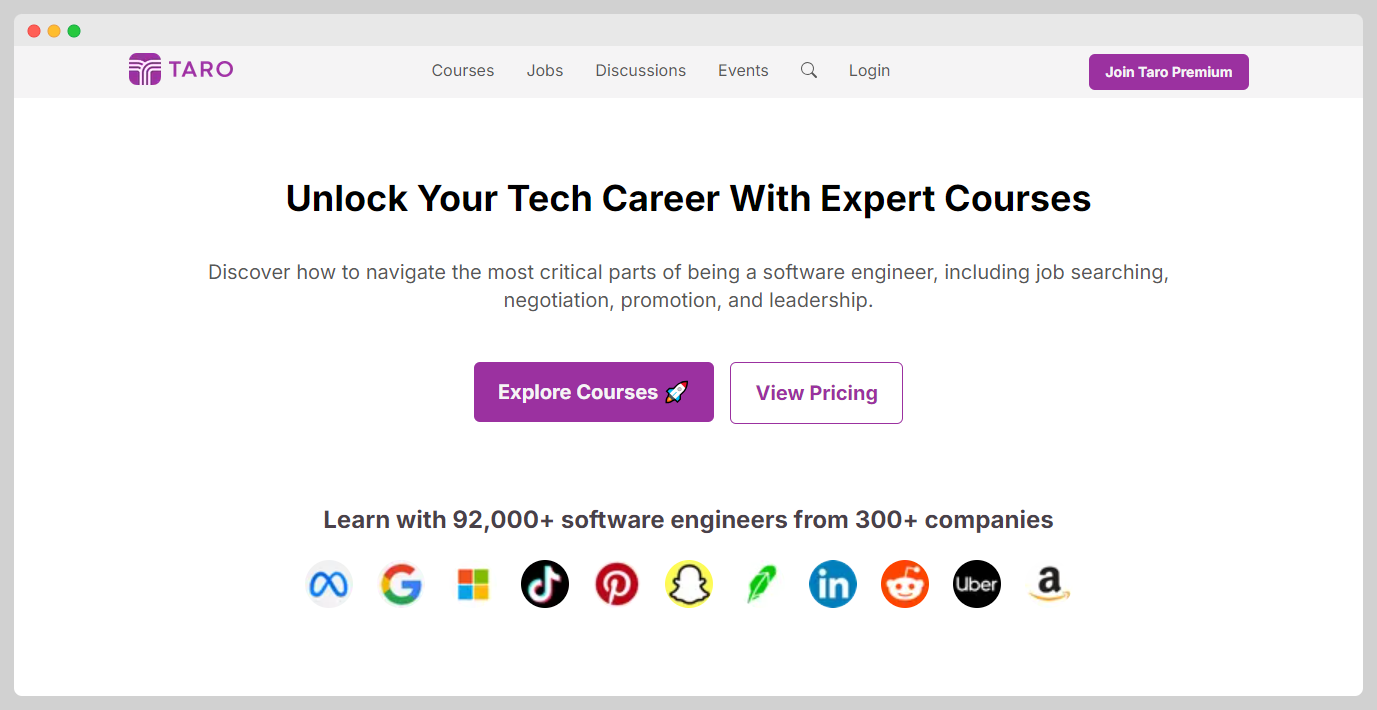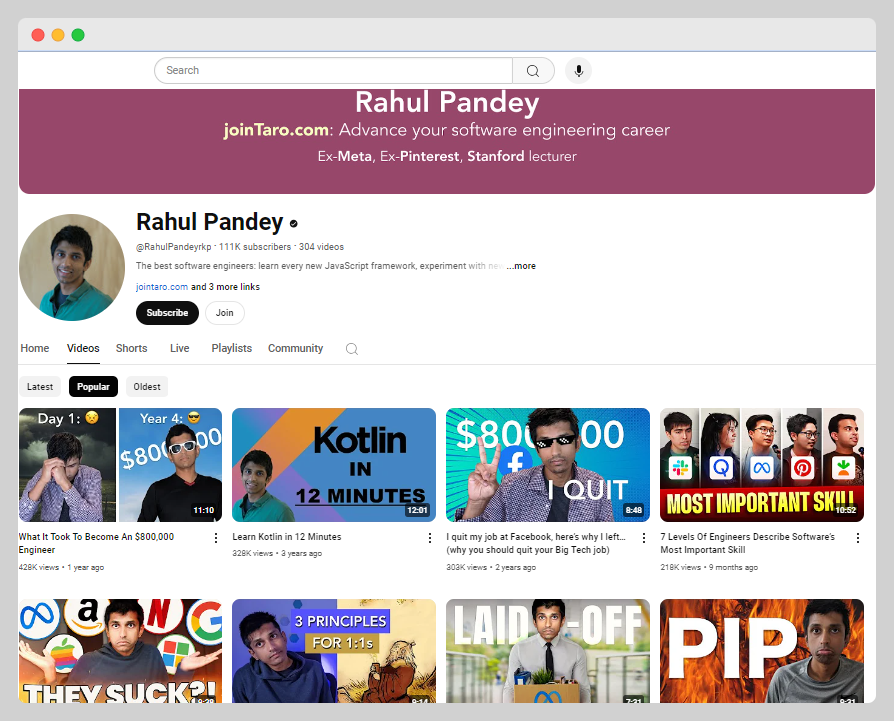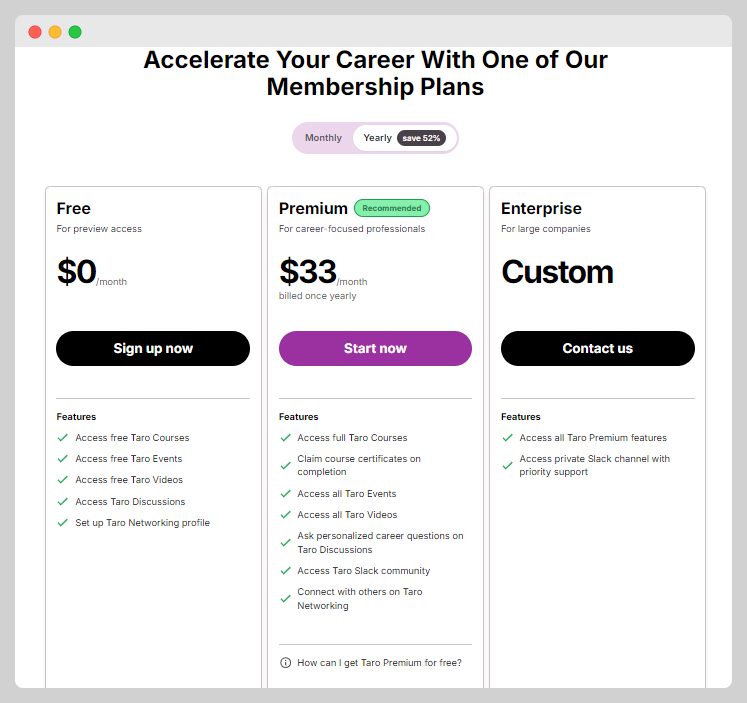How 2 Ex-FAANG Engineers Built Taro to $50K MRR in 2 Years
Who is Rahul Pandey?
Rahul Pandey, co-founder of Taro, is a Stanford graduate in Computer Science who started his career at tech giants like Pinterest and Facebook before venturing into entrepreneurship with Y Combinator's support. Originating from Michigan, he has built a reputation for his expertise in software engineering and career growth insights, partly through his successful YouTube channel.
What problem does Taro solve?
Taro gives software engineers actionable, credible career advice, helping them navigate complex career challenges like promotions and management, which traditional education often overlooks.

How did Rahul come up with the idea for Taro?
Rahul Pandey came up with the idea for Taro through a combination of his personal experience and feedback from the community he built. Initially, he created a YouTube channel to share career growth advice based on his experiences moving up the ranks in tech companies like Facebook and Pinterest. As his channel grew to 100,000 subscribers, he noticed a significant demand for this type of content, revealing a gap in resources for helping software engineers navigate their careers.
This realization was further validated through seminars he hosted with his co-founder, attracting thousands of engineers and confirming the need for more focused career development resources. Before fully committing to Taro, they refined their concept through the Tech Career Growth community, adjusting their content based on user feedback and the specific concerns raised during events. Despite the challenges of narrowing down a broad idea into a coherent product, Pandey's commitment to addressing a well-defined problem eventually led to Taro’s focused mission of providing insider career growth advice for software engineers.
How did Rahul build the initial version of Taro?
Taro was initially built by Rahul Pandey and his co-founder Alex Chiou through a lean and iterative development process. Drawing from their strong engineering backgrounds at FAANG companies, they utilized a tech stack that included Firebase for app development, using native mobile apps and Next.js for the web to facilitate rapid testing and deployment. The first version of Taro came together by leveraging existing content: they repurposed materials from their "Tech Career Growth" seminars and live events, which had already engaged thousands of software engineers. This approach allowed them to quickly test the demand and refine the product based on user feedback. Development wasn't without its hurdles; they struggled initially with clarity in their product's value proposition, which they refined over time by continuously engaging users to better tailor their offerings.
What were the initial startup costs for Taro?
- Seed Funding: Taro received $500K in seed funding from Y Combinator.
How did Rahul launch Taro and get initial traction?
Tech Career Growth Community
Rahul Pandey and Alex Chiou decided to leverage their audience by hosting free online seminars on career-related topics for software engineers during the pandemic. These seminars grew significantly, attracting thousands of attendees.
Why it worked: Hosting these webinars allowed them to directly engage with potential users and create value upfront. The rich interactions in these sessions built a robust network and community, which eventually converted into paying customers for Taro Premium.
YouTube Channel
Pandey had a growing presence on YouTube since 2019, initially sharing his journey and learnings in Android development. He later refocused on broader software engineering career advice. By the time Taro was ready for launch, his channel had amassed a significant following of 100,000 subscribers.
Why it worked: The YouTube channel served as a durable distribution channel, enabling consistent communication with a large, engaged audience. This credibility and rapport with viewers translated into a receptive audience for Taro's offerings, driving user sign-ups and conversions to the premium membership.
LinkedIn Engagement
Both founders actively posted on LinkedIn, contributing valuable content pertaining to software engineering and career growth. By posting almost daily, they amassed millions of post impressions and tens of thousands of clicks directed to Taro.
Why it worked: Frequent, high-quality posting on LinkedIn tapped into a professional network, driving organic traffic and engagement. This platform effectively reached their target demographic—tech professionals who are keen on career advancement, leading to increased visibility and user acquisition for Taro.
Metrics:
- By the time they launched their premium service, they had built a community of thousands of software engineers.
- The YouTube channel, driving 70% of paid members, and LinkedIn posts, which garnered millions of impressions, were crucial in achieving rapid growth.
- Achieving $50K in monthly recurring revenue (MRR) highlights the effectiveness of their early distribution and community-building tactics.
What was the growth strategy for Taro and how did they scale?
YouTube
The company started their YouTube channel in late 2019 and gradually built a following by sharing insights on career navigation for software engineers. They reached 100k subscribers, which highlighted a demand for career growth advice from credible sources. About 70% of their paid members initially discover Taro through YouTube, where most videos include a plug for Taro Premium.

Why it worked: YouTube allowed Taro to build a deeper level of trust with potential customers. The platform's visual nature helped convey complex career advice more effectively, and regular video publishing established consistency and reliability. Rahul emphasized the importance of a strong idea, title, thumbnail, and editing to generate engagement. Over time, this led to significant brand recognition and conversions to Taro Premium memberships.
Rahul and his cofounder, Alex, post on LinkedIn almost daily, resulting in millions of post impressions weekly and tens of thousands of clicks into Taro. They developed a playbook for growing on LinkedIn, which involves finding good discussion topics from Taro, adding personal narratives or opinions, and driving traffic to Taro's platform.
Why it worked: Consistency and strong hooks are key to their LinkedIn success. Sharing posts that offer a robust point of view helps capture attention and drives user engagement. These posts often direct readers to valuable discussions on Taro, boosting traffic and user sign-ups. While the method may seem straightforward, maintaining this level of consistency and quality interaction helps build brand authority and user trust.
Email Marketing
Although not elaborated in detail, email marketing was highlighted as a durable distribution channel. Taro can directly reach users without relying on algorithms, making it a reliable method for sharing updates and offers.
Why it worked: Email provides direct access to users who have shown interest, allowing Taro to maintain engagement over time. It's less dependent on platform algorithms, ensuring that the intended audience receives the communication. The success of their email marketing reinforces the importance of building and maintaining a quality email list.
Live Events
Taro holds free live Zoom calls every few months on topics relevant to software engineers, like "surviving layoffs" or "how to evaluate a manager." These events provide substantial value and typically include a promotion for Taro Premium at the end.
Why it worked: Live events create an interactive space for potential users to engage with Taro's content in real-time, giving Rahul and his team a chance to demonstrate their expertise and the value of their paid offerings. The high value of these sessions makes attendees more likely to convert to paying users, effectively blending community engagement with marketing.
What's the pricing strategy for Taro?
Taro employs a freemium pricing model, offering most content for free while charging $33/month or $396/year for Taro Premium, which unlocks full course catalog and community access.

What were the biggest lessons learned from building Taro?
- Leverage Your Network and Unique Advantages: Instead of cold applying to numerous job postings, utilize personal connections and find where you have an "unfair" advantage. This means leveraging your network to find referrals, which drastically increases your chances of landing a job.
- Build Public Trust and Presence: Regularly share valuable content on platforms like LinkedIn or YouTube to build credibility in your field. Post consistently, provide valuable insights, and grow your audience over time to establish trust.
- Focus on Depth Over Breadth Early On: Dive deep into one area of expertise to develop a strong skillset that makes you a top-tier candidate in that niche. For example, becoming a highly skilled Android developer can set you apart in a specific market, making you an attractive hire due to your specialized knowledge.
- Effective Communication and Soft Skills: Hone soft skills such as asking clear, insightful questions and engaging in proactive communication. These skills can significantly improve how you are perceived by peers and superiors and can aid in your career progression.
- Adapt and Innovate with Feedback: Always seek feedback from users or colleagues to refine and clarify your product or service offerings. This iterative process helps in honing in on what truly adds value to your audience or customers, ensuring that you stay relevant and effective in your role.
Discover Similar Business Ideas Like Taro
Teacher Jade's online academy and consulting services, which teach youth and adults how to offer online classes, resulted in a five-figure monthly income with increased enrollment through Outschool, leading to the creation of a second business and a plan to expand course offerings and salaries for her teachers.
Learn how Alex Albarran grew his online marketing and business consulting company to achieve a gross revenue of $541k per month, with 3x revenue growth over 15 months, and a team of 8 members, while helping entrepreneurs close the gap between where they are and where they want to be in their business, life, and wealth.
More about Taro:
Who is the owner of Taro?
Rahul Pandey is the founder of Taro.
When did Rahul Pandey start Taro?
2022
What is Rahul Pandey's net worth?
Rahul Pandey's business makes an average of $50K/month.
How much money has Rahul Pandey made from Taro?
Rahul Pandey started the business in 2022, and currently makes an average of $600K/year.

Download the report and join our email newsletter packed with business ideas and money-making opportunities, backed by real-life case studies.

Download the report and join our email newsletter packed with business ideas and money-making opportunities, backed by real-life case studies.

Download the report and join our email newsletter packed with business ideas and money-making opportunities, backed by real-life case studies.

Download the report and join our email newsletter packed with business ideas and money-making opportunities, backed by real-life case studies.

Download the report and join our email newsletter packed with business ideas and money-making opportunities, backed by real-life case studies.

Download the report and join our email newsletter packed with business ideas and money-making opportunities, backed by real-life case studies.

Download the report and join our email newsletter packed with business ideas and money-making opportunities, backed by real-life case studies.

Download the report and join our email newsletter packed with business ideas and money-making opportunities, backed by real-life case studies.



